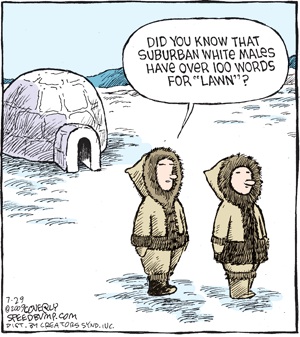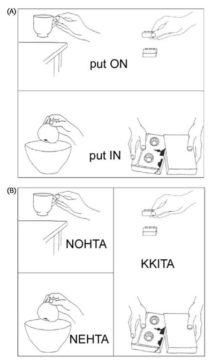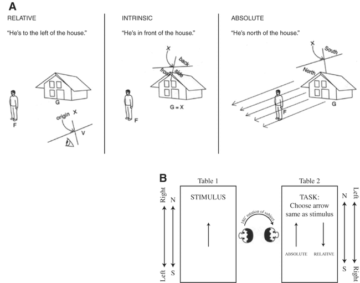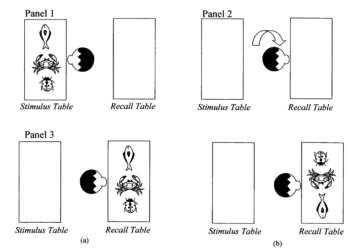by David J. Lobina

After sort-of dissing James Joyce last time around – 0 comments, though! I expected Colm Tóibín to demur or something – this month I was meant to outline what the language of thought is supposed to be like, thus bringing to an end this series on the relationship between language and thought. But before getting to the details of the representational-conceptual system with which we think our thoughts, and in view of the posts I have devoted to claiming that we don’t think in any natural language – that we really don’t think in any language! – I ought to at least discuss the possibility that different languages may well have an effect on the sort of thoughts available to their speakers.
That there might be cross-linguistic differences in cognition is a rather common belief, in fact – who hasn’t been told that this or that word in this or that language is impossible to translate, for instance? – and it has received quite a bit of attention in both academia and the popular science press.
The locus classicus, as it were, is the so-called Sapir-Whorf Hypothesis, which is really a family of statements, and hardly a well-defined research question. As a sample, these quotes from Edward Sapir and Benjamin Whorf, after whom the “hypothesis” is named:
‘think, or even reason, without a language is an illusion’ (Sapir’s Language)
the ‘system of each language’ as a ‘shaper of ideas’ (Whorf’s Language, Thought, Reality)
These give an indication of the direction Sapir and Whorf were headed, and such comments are common in their works (though not always consistently; indeed, Sapir and Whorf often contradict themselves). More useful is to identify a clearer research position to tackle, and this one prediction from Whorf will do – namely, the prediction that speakers will not be
‘led by the same physical evidence to the same picture of the universe, unless their linguistic backgrounds are similar’
A claim according to which there must be a systematic relationship between the grammatical categories of a community’s language and how that community will understand the world, the Sapir-Whorf Hypothesis itself comes in different flavours, not least in strong and weak versions. The strong version, also known as linguistic determinism, has it that the structure of a language determines the way in which we think, whereas the weak version, known as linguistic relativity, states that different languages create different (but not entirely incommensurable) ways of thinking.
Perhaps the most famous case of this general position is the “the great Eskimo vocabulary hoax”, as the linguist Geoffrey Pullum calls it (this is also the title of a book Pullum has written on this and related topics). The hoax refers to the now discredited claim that Eskimos have multiple words for snow, these words describing different grades and types of snow, and thus showcasing a rather different conceptualisation of the world.
The anthropologist Franz Boas (Sapir’s teacher, actually; all bad ideas remain within the family; what a slander that is) identified a number of Eskimo words for snow – aput: ‘snow on the ground’; qana: ‘falling snow’; piqsirpoq: ‘drifting snow’; qimuqsuq: ‘a snow drift’ – and the New York Times in 1984 opined that the Eskimos distinguished 100 types of snow.
The overall claim is technically incorrect, as I shall point out in a minute, but even if it wasn’t, it would be quite unremarkable. English uses multiple words to refer to the different states of water (lake, river, brook, rain), different shapes of fonts (Arial, Georgia, Times New Roman, etc.), and even for snow (sleet, blizzard, slush, etc.), and so do many other languages on multiple of things – so what is the big deal?
The truth of the matter, in any case, is that the West Greenlandic language (to identify one Eskimo language) has two words for snow, shown below, but given that these languages are agglutinative, further suffices can be added to words to create whole sentences, and thus further modifying, if so, such a noun as snow. In this sense, what may well look like a whole new word for snow, it is often in fact a whole sentence in which snow is mentioned.[i]
qanik: snow in the air; snowflake
aput: snow on the ground
Still, cross-linguistic differences do exist, and these could well have an effect on cognition. At first sight this is very plausible. How could the following features not result in incompatible ways of thinking? Some Australian aboriginal languages only exhibit a handful of verbs; Navajo has no regular verbs; Cantonese uses different tones to identify various words; Pirahã supposedly has no more than ten sounds; Naasioi apparently has two hundred genders; Maybrat has no tense in its verbs, e così via.
But do these differences translate (sic or no sic?) into different ways of thinking? I mentioned earlier that the popular science literature has shown plenty interest in the Sapir-Whorf Hypothesis, with these possibly constituting the main three: Guy Deutscher’s Through the Language Glass, Steven Pinker’s The Stuff of Thought, and John McWhorter’s The Language Hoax. The last two argue that the relevant experiments show that the effects are subtle but, in the end, rather minor, and this will be my line here too.
I will briefly discuss five case studies from the academic literature to make this point, which are representative, I think, of where our knowledge on these matters currently sits.
Case Study I: Evidentiality
Evidentiality refers to how languages indicate the nature of a statement’s evidence, a source of information usually conveyed by linguistic elements called evidentials. English marks this information lexically, as indicated by the italics in the sentences below, whereas a language such as Hopi, which Whorf studied, marks it in the complementizer that, as indicated by the underlining (I’m using English sentences to make this point, but nothing is lost by so doing).
I see that it is raining
I hear that it is raining
Whorf’s analysis of Hopi was not all that good (he was an amateur linguistic, after all; another slander), but there is a better comparison to be had, and that’s between English and Korean, as the latter has a dedicated set of morphemes to mark information source, for none of English. Would this mean that children learning Korean would come to understand the conceptual underpinnings of evidentiality – as evidenced (no pun intended), for instance, in the ability to report how they came to some information – before children learning English?
A clear enough prediction, and one that Anna Papafragou and colleagues put to the test by using a non-linguistic reasoning task in which young children were instructed to search for a number of objects in a container and then were asked to report how they came to discover its contents. The experiment was conducted with two groups of 4-year-olds, one was composed of English-speaking children, and the other of Korean-speaking children, and the results show that there were no differences between the two groups, and thus, that the respective conceptual bases regarding evidentiality appear to develop similarly.
Case Study II: Categorical perception
A second case in point is categorical perception, the ability, for instance, to discriminate between ba and pa sounds (this is a difference between two different but related phonemes). At the beginning of the language acquisition process – that is, when children start learning a language – children are capable of discriminating all the possible sounds of the world’s languages, but as they start tuning in to their native language, they soon conform to the sounds they continue to hear. A phenomenon often called “learning by forgetting”, children lose the ability to discriminate phonetic distinctions that are not phonemic – that is, not part of their language – making these distinctions inaccessible to them. In this sense, the language you learn influences acoustic perception, but this is not quite a neo-Whorfian effect (let’s call it that), as it is not a difference in thought per se.
How about hue perception, though? Consider the words Berinomo (or Berinmo) and English employ to refer to the same palette of colours, as shown below.

On the face of it, the language you speak would appear to have an effect on how you label colours, that is, on how colours are categorised. But do these names have an effect on how the different hues are perceived to boot? The case of colour-blindness would suggest this is not the case, as red-green, colour-blind individuals categorise colours the same way as people who do not suffer colour blindness – to wit, red and green are placed at the edges of a colour palette, with brown in the middle. As such, there would appear to be a certain independence between hue perception and labelling, indicating a minor effect of language.
Case Study III: Motion
A third example has to do with the ways languages refer to different kinds of information regarding motion, the case I want to discuss involving a distinction between “manner of motion” and “path information”. Consider English again, which codifies manner of motion directly in the verbs, and adds path information through the use of prepositions and the like:
walk, crawl, slide, float (manner of motion)
away, out of, into, down (path information)
Spanish, on the other hand, codifies path information in the verbs, and adds manner of motion through verbal phrases and the like (note that the translations into English within parentheses):
entrar (go in), salir (go out), subir (go up) (path information)
andar a gatas (to crawl) (manner of motion)
Quite a different way to express these two sources of information, but do these approaches result in conceptual differences, the usual question I have posed in this post? There are two main results to note: (a) English and Spanish speakers use different terms to describe the same visual stories, which is certainly an important effect; but (b) there are no differences in non-linguistic experiments such as classification or memory tasks across languages when it comes to reporting either the manner of motion or path information – in fact, there are no differences even within same language when a non-linguistic task is employed.
Here too it seems to be the case that the conceptual representations of motion and location are independent of the corresponding forms languages employ to express this information – there is an effect, but from the perspective of the neo-Whorfian, it is quite a minor one.
Case Study IV: Spatial relationships
The way different languages encode spatial relationships brings us to another distinction between English and Korean – and maybe this time it will bring us to a conceptual distinction too. Korean verbs directly codify some information regarding geometry and location, information usually conveyed by prepositions in other languages. A relevant example is the English verbal phrase to put in, which corresponds to two forms in Korean, depending on the fit between the object and the container in which the latter is put (the actual putting in):
kkita: tight fit
nehta: loose fit
In this sense, English collapses the tightness-looseness relation by using the same verb for either case. Interestingly, what Korean conflates is verbal phrases such as putting in and putting on, but once again keeps to the distinction between tightness and looseness, in the case of putting on in terms of support:
kkita: tight support
nohta: loose support
Hard to understand what I am getting at? Let me use a graphic to describe the situation:

As shown in (A), English uses the verbal phrases putting in and putting on in cases where there’s a distinction to be had, in the one case, between a tight and loose support (putting on), and in the other, between a tight and loose containment (putting in). But in the case of Korean, shown in (B), the same word is used for putting in and putting on in those cases in which the containment and support relationship is of the same kind – no(e)hta when the containment/support is loose, kkita when it is tight.
According to a study by Laraine McDonough and colleagues from 2003, both English and Korean pre-verbal children are sensitive to all these distinctions, and so are Korean-speaking adults, but this is not the case for adult English speakers, as they are only sensitive to the in/on distinction. Is this finally a case of a linguistic distinction turning into a conceptual difference?
Hold your horses, for this result only obtains when participants carry out a linguistic task, and it ought not to be surprising to get a linguistic effect in a language-mediated task. Turn the experiment into a non-linguistic task that tracks the same conceptual distinctions as the relevant linguistic words and phrases, which is what McDonough et al. did with a “similarity task”, and the differences between linguistic groups all but disappear. Again.
Case Study V: Spatial frames of reference
A final example involves the different spatial frames of reference the world’s languages use. What do I mean by spatial frames of reference? Consider these three ways to refer to how one can spatially relate to a house, say:
Absolute spatial coordinate system: to the north, to the south, etc.
Relative, or viewer-perspective, system: to the left of, to the right of, etc.
Intrinsic system: in relation to an object
Naturally, different languages codify this information differently, and according to the noted psychologist Stephen Levinson and colleagues, this has an effect on how people reason about space – and what clearer neo-Whorfian effect that something that language does to reasoning! As before, a graphic will help describe the issues at hand; (A) below depicts the three spatial frames of reference I have described:

Levinson and colleagues conducted a number of experiments with various languages and found significant linguistic effects on reasoning. One such experiment involved the languages Guugu Yimithirr and Tzeltal. Guugu Yimithirr uses an absolute system – it is north of me and not in front of me – which is supposed to follow from the fact that these speakers live in a flat terrain. Tzeltal speakers, on the other hand, use phrases such as it is uphill instead of to the left of, and these speakers live in a mountainous region.
The experiments that were conducted, shown in B in the graphic, were simple enough. Participants are presented some objects on a table in a specific lay-out; participants are then rotated 180 degrees to another table and are handed the same objects; once they have been given the objects, the participants are asked to reproduce the array in the same way as had been presented on the other table. And well, what happens is that participants rearrange the objects according to the coordinate system of their language, and so difference between groups arise. Sounds confusing? A graphic will explain once more.

Panel 1 shows the initial set-up, with the “stimulus table”; Panel 2 shows how the participant is rotated to what is the “recall table”, where the task is carried out; and in Panel 3 there are two possible rearrangements, the one in (a) showcasing an absolute coordinate system, and the one in (b) a relative system. Two rather different outcomes, and this really does seem like a neo-Whorfian effect.
Or maybe not. A clever modification of the experiment has shown that the way people behave when it comes to spatial frames of reference depends upon rather specific conditions. That is, under the right conditions, speakers can behave in ways other than in the coordinate system that their language favours. In the case of English, speakers can behave as if their language favoured an absolute frame of reference if the experimental task introduces landmarks – an absolute system relative to landmarks such as downtown, uptown, etc. – but according to a relative system if the landmarks are absent. If so, the details of a language’s frames of reference don’t preclude the possibility that their speakers can conceptualise, and indeed use, spatial systems supposedly not available to them.
Coda
The bottom-line of all this is that linguistic determinism is very unlikely, as it is hard to find, if not impossible, for they might not exist, conceptual gaps among languages. There are plenty of communicative gaps, at least in terms of words and phrases that are supposed to be impossible to translate directly (that is, on a one-to-one basis), though the actual content to communicate – the relevant meanings and concepts – can always be expressed in some way, even if with longer phrases. It is a curious feature of the history of the Sapir-Whorf Hypothesis that most of the scholars who defended the strong version of the hypothesis were seemingly unaware of the irony that as English speakers (for they were mostly English speakers) they didn’t have much trouble understanding the conceptual underpinnings of languages they didn’t speak or understand, even though this conceptual baggage should have not been available to them (that was the whole point, wasn’t it?).
Be that as it may, there are linguistic effects, and these support a form of linguistic relativity, though in the context of some of the grand claims of the Sapir-Whorf Hypothesis, these effects are all quite minor. What I think is much more likely is a weak form of the hypothesis sometimes termed ‘‘thinking for speaking’’, an expression that Dan Slobin came up with in the 1990s (Pinker had made a similar point in some of his work from the 1980s, when he was a serious cognitive psychologist; final slander of the day). This is the claim, broadly, that the categories codified in one’s language are often a reflection of the lives the speakers lead. Or said otherwise, that the most prominent features of one’s environment or culture have a better chance to make it into one’s language, but the language of thought is the language of thought. Why would it be surprising if the Eskimos did have hundreds of words for snow, then? (But remember, they don’t!).
[i] I will mention a number of languages in this post, but won’t provide many details about them, let alone where they come from – instead, they all will be hyperlinked to Wikipedia, and you do the rest. Same with some technical terms I might mention here and there, such as agglutinative languages.
